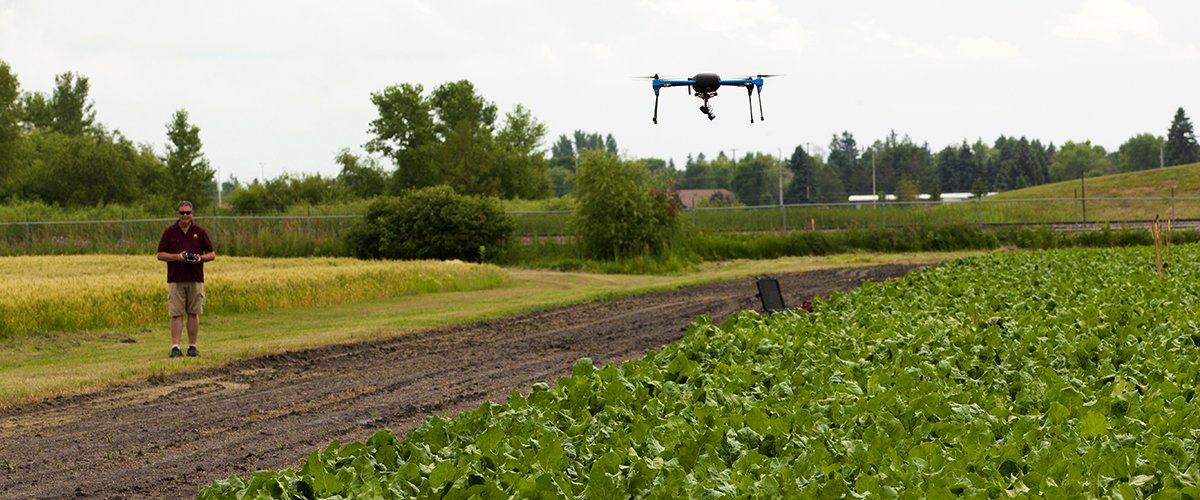Pest management research at the NWROC addresses both insect and disease pests of potatoes, small grains, and sugarbeets. Our work also utilizes a remote sensing and digital mapping tools to monitor spatial and temporal distribution of insect populations and pesticide resistance. We collaborate with growers and other researchers to both conduct our research and share our results.
Small Grains Pest & Disease Management
The small grains pest and disease management applied research program focuses on developing environmentally and economically sustainable pest and disease management tactics. Studies incorporate remote sensing, weather analyses, GIS, and other geospatial tools to determine where and when insect problems or disease are developing and at economically impactful levels. We utilize this information to develop treatments that are only applied when and where necessary.
By targeting applications in fields, the over-application and waste of insecticides and pesticides can be avoided. This promotes the profitability of small grains production while also minimizing environmental impacts.
We collaborate with growers and other researchers to conduct trials in fields as well as on NWROC research land. Trials are conducted to fill information gaps regarding pest and disease management, to control current outbreaks, and to prevent potential outbreaks. We focus on not only the pest problems of today, but those of the future as well.
Potatoes
Our potato research and outreach program focuses on economically controlling the insects that hinder potato production in Minnesota. Our studies focus on both common and emerging pests in potato production, including the insect vectors of potato virus Y (PVY), potato leaf roll virus, and Purpletop, and long-standing insect pests such as Colorado potato beetle. We work closely with other researchers and growers in Minnesota, North Dakota, other states, and Canada to provide the most up-to-date information on potato insects and how to effectively manage them.
Aphid Vectors of Potato Virus Y (PVY)
Potatoes are not produced with ture seed, rather they are grown from pieces of tubers grown especially for that purpose. Potato Virus Y has become a pandemic in potato seed industry globally and is the most important factor limiting the supply of certified disease-free potato seed in the United States. PVY and other viral diseases require transmission by pathogen-carrying aphids, or vectors. In addition to a number of indigenous aphids, a new invasive species (i.e., the soybean aphid), has played a significant role in increasing rates of transmission. New asymptomatic strains of the virus, PVYNO, PVYN, and PVYNTN, which can cause tuber necrosis, have also played a role in this increasing epidemic. These factors make PVY a concern in both the commercial and seed potato production industries.
Movement of PVY inoculum involves a number of aphid vector species. Potato virus Y is a non-persistent virus, meaning an aphid can become infected almost immediately upon feeding on an infected plant and can, in turn, immediately infect the next plant upon which it feeds. Consequently, the spread of PVY within a seed field can occur rapidly.
There are a number of well-established strategies in managing PVY, one of which is vector control. This involves the use of crop oils and insecticides that reduce feeding and probing behaviors of the aphid vectors. The application of these management techniques requires appropriate timing to be effective.
To help growers manage vector populations, we established a series of aphid suction traps in 20 locations in Minnesota and North Dakota. With the assistance of grower cooperators, trap catches are gathered weekly and sent to the entomology laboratory at the NWROC. We identify aphid species in all location samples and share the weekly counts with potato producers via ListServs, weekly email updates through the Northern Plains Potato Growers Association and via blogs (i.e. aphidalert.blogspot.com ).
These weekly reports provide growers with information on when to start the application of management tactics. The updates also provide insight into the regional population dynamics of aphid vectors. For example, certain species of aphids are more efficient at spreading PVY than others and post a much greater risk. Our reports incorporate the PVY vector risk index for each type of aphid, so growers know which species of aphids they need to respond to at what population levels.
Remote Sensing
Remote sensing is the science of obtaining information about an object or area through the analysis of measurements made at a distance from the object (i.e., not coming in contact with it). The use of remote sensing in agriculture offers great potential for developing environmentally and economically sustainable management practices.
The NWROC remote sensing research program uses technology to identify insect and disease damage in fields and develop targeted treatment plans. By identifying when and where pest and disease problems are, treatment plans can be developed that apply chemical inputs only when and where necessary, rather than to the entire field

